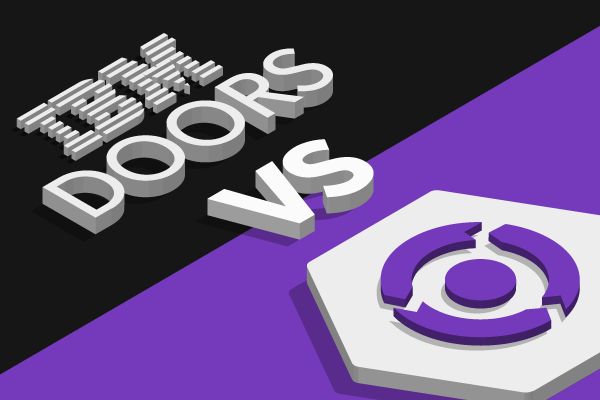
Helix ALM vs. Doors Next
What is Helix ALM?
Helix ALM is an application lifecycle management tool, which includes requirements management, test case management, and issue management. It is applicable across a broad range of methodologies, including modern agile practices, traditional waterfall development, or a hybrid approach. Because it encompasses a broad scope of records and team activities, Helix ALM specializes in end-to-end traceability and configurable workflows.

What is DOORS Next?
DOORS is the shortened name used in this article for IBM Engineering Requirements Management DOORS Next. DOORS Next was derived from IBM Rational DOORS, a requirements management platform that was originally published in 1991. With a focus on large, highly complex deployments, DOORS Next was designed to improve collaboration among various stakeholders by being built on Jazz.net.
Requirements Management
Requirements management within Helix ALM is a collaborative experience, which blends structured requirement decomposition with rich content such as diagrams, images, and tables. Each requirement maintains its unique ID, workflow, history, and traceability. Non-requirement records such as risk artifacts (Hazards, FMEAs, Risk Controls, etc.) and agile work items (User Stories, Tasks, etc.) live alongside product requirements, and may be processed using both traditional document-based design, as well as agile approaches such as sprints and Kanban boards.


Requirements Management within DOORS Next takes place within modules, which are analogous to requirements documents. Similar to Helix ALM, requirements in DOORS Next are discrete objects, which allows for granular traceability.

Risk Analysis
Both systems provide risk-based development, through hazard analysis, risk identification, and traceability of risk artifacts to the product requirements mitigating those risks. While both systems support ISO 26262, Helix ALM specifically supports risk models for additional industries, such as ISO 14971 or IEC 62304 for medical device development. Below are screenshots comparing ASIL classification in DOORS Next and Helix ALM.


Traceability
Both Helix ALM and DOORS Next feature robust traceability. Each system creates meaningful links among all your artifacts, to represent the nature of the relationships within your product development. As a result, impact analysis occurs automatically via “Mark Suspects” in Helix ALM, and the “Suspicion Indicator” within DOORS Next, providing a proactive view of which artifacts may be affected by a potential change.
Both Helix ALM and DOORS Next offer traceability not just among your requirements and risk artifacts, but to testing and change management records as well. DOORS Next offers this through IBM Engineering Test Management, which integrates with DOORS Next. Helix ALM was built from the ground up as a requirements, testing, and issue management suite, meaning no integration is necessary.
Both systems offer code-level traceability, which is a requirement in the aerospace industry. DOORS Next graphically represents traceability via traceability path diagrams, whereas Helix ALM features configurable traceability matrix reports.


Third Party Integrations
DOORS Next allows integrations via OSLC, which provides access via Java client programs. You may also use client extensions, which enable mini-dashboards with access to artifact data, built on HTML, CSS, and JavaScript. Historically, Rational DOORS used its own programming language with a syntax like C and C++, called DXL. Several paid third-party extensions are also available to integrate with DOORS Next.
Helix ALM offers a highly functional REST API, which enables all CRUD operations, traceability, and workflow management to be done in easily digestible JSON format. The REST API is commonly used to integrate with your CI/CD ecosystem, populating Helix ALM as the ‘single source of truth,’ with data from various other tools, such as automated testing platforms or build pipeline managers.
Both systems support ReqIF import, meaning data may be transferred from another system that offers ReqIF export functionality.
Administration
Ultimately, the difference between Helix ALM and DOORS Next can be described in two words: customization vs. configuration. DOORS Next is a customizable tool, which means coding is required to enable specific functionality. For instance, both ASIL and FMEA extensions require implementing source code, which is outlined in the comments of this library article.
Helix ALM is a configurable tool, which means this sort of setup is done via a point-and-click interface. Everything including workflow structure; calculated fields; and even automation is performed in the user interface, with no coding required. As an example, below is a screenshot showing the calculated output given the inputs of a Severity score, and post-mitigation Probability and Detection scores. Please note that the table shown below is interactive to the administrator performing this configuration.

Price
Pricing is variable for both Helix ALM and DOORS Next, based on factors such as the number of licenses, team size, deployment method (cloud vs. on-premise), and features included. For instance, IBM provides some ‘bundles’ of DOORS products, but purchasing both DOORS Next and IBM Engineering Test Management will double the price to obtain both licenses.
Overall, Helix ALM is a significantly more cost-effective solution to license. There are no hidden fees, as all features are included upfront, including API access; risk management; and traceability among requirements, tests, and issues.
Additionally, the configurability of Helix ALM vs the customization of DOORS Next means that implementation, administration, and ongoing maintenance costs are much lower in Helix ALM than in DOORS Next.
Conclusion
Both DOORS Next and Helix ALM are established, and trusted systems deployed globally in various industries. They both feature rich requirements management, collaboration, and traceability, although Helix ALM natively includes test and issue management without needing additional integrations.
DOORS Next has been leveraged for extremely large and complex deployments, and its customizability allows for a tailored experience, given enough administrator and developer resources.
Helix ALM is applicable across a broad range of industries and team sizes. It is heavily used in small, medium, and large regulated industries, and is a more cost-effective and efficient solution to deploy than DOORS Next in all but the very largest installations.